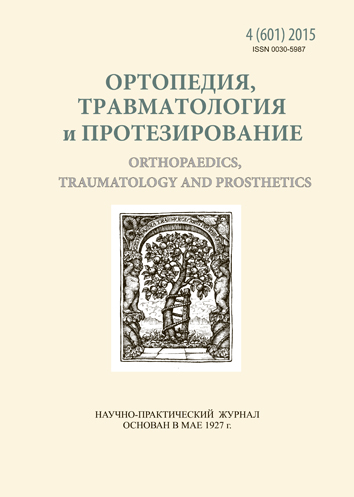About the methodology of investigation of hip replacement
DOI:
https://doi.org/10.15674/0030-598720154123-127Keywords:
joint replacement, hip joint, morphoimplantation group, predictionAbstract
The quantity of complications after hip replacement still remains significant (8–15 %) despite the great amount of scientific working-out and huge clinical experience. Goal: to produce methodological supplies of the investigation of hip replacement for its further improvement. Results: maintaining of long-term stability of endoprothesis related to the choice of appropriate implant design, categorization of its criteria and prediction of implants influence on joint elements. Traditionally the technique of operation is chosen according to the stage of disease. In the case of joint replacement some contradiction appears: the endoprothesis’ with different design are used on the same stage of disease. The specialists face the same problem during the differential choice of implant and algorithmic selection. So, it’s quite obvious, that taking into consideration just the stage of disease reduces the value of attempt of full-scale analysis of the efficacy of long-term functioning of endoprothesis, and efficacy of algorithmic choice of implant. New methodological form should be put in the methodology of joint replacement, that significantly enlarge the possibilities of description of hip pathological changes within the frame of existing diseases’ classification. Lets call this form as «morphoimplantation group» that combine clustered morphological changes in joint elements of hip and clinical criteria in the frame of classification of pathological process, that determine the choice of implant element. The forming of morphoimplantation groups defines the type of implant module according to particular case. The combination of morphoimplantation groups within the frame of disease stage classification determines the variations of using of implant modules. Conclusion: the use of morphoimplantation group as a methodological approach to the choice hip endoprothesis design will help to systemize and algorithmize the choice of implant that will lead the prediction of endoprosthesis behavior on new level and provide its long-term functioning.References
- Korzh A. A. Orthopaedy in Ukraine on the frontier of centuries / A. A. Korzh // Orthopaedy, traumatology and prosthesing. — 2000. — N 1. — P. 5–9.
- The algorithm of elaboration of indications and contraindications for hip joint replacement / A. E. Loskutov, A. E. Oleynik, M. L. Golovakha, D. A. Sinegubov // Herald of traumatology, orthopaedy and prosthesing. — 2004. — N3 (42). — P. 8–12.
- Loskutov A. E. Bilateral hip joint replacement / A. E. Loskutov, D. A. Sinegubov. — Dnepropetrovsk: Weirs, 2008. — 292 p.
- Zagorodniy N. V. Hip joint replacement: the basics and practice: manual / N. V. Zagorodniy. — M.: GEOTAR-Media, 2012. — 704 p.
- Manual for hip joint replacement / edited by R.M. Tihilov, V.M. Shapovalov. — SPb.: RNIITO named after R. R. Vreden, 2008. — 324 p.
- National Joint Registry for England, Wales and Northern Ireland. 10th Annual Report 2013 [electronic resource]. — Access: http://www.njrcenter.org.uk.
- Registro ortopedico Lombardo Ptotesi. Sesto Raporto — Novembre 2012 [Electronic resource]. — Access: http://www.sanita.regione.lombardia.it/es.
- The Norwegian Arthroplasty Register. Report June 2010. [Electronic resource]. — Access: http://www.haukeland.no.
- The Geneva Hip Arthroplasty Registry. Annual report 2010. [Electronic resource]. — Access: http://www.efort.org.
- Zimmer Holdings, Inc. 2008 Annual Report: [electronic resource]. — Access: http://www.zimmer.com.
Downloads
How to Cite
Issue
Section
License
Copyright (c) 2015 Oleksandr Oleynik

This work is licensed under a Creative Commons Attribution 4.0 International License.
The authors retain the right of authorship of their manuscript and pass the journal the right of the first publication of this article, which automatically become available from the date of publication under the terms of Creative Commons Attribution License, which allows others to freely distribute the published manuscript with mandatory linking to authors of the original research and the first publication of this one in this journal.
Authors have the right to enter into a separate supplemental agreement on the additional non-exclusive distribution of manuscript in the form in which it was published by the journal (i.e. to put work in electronic storage of an institution or publish as a part of the book) while maintaining the reference to the first publication of the manuscript in this journal.
The editorial policy of the journal allows authors and encourages manuscript accommodation online (i.e. in storage of an institution or on the personal websites) as before submission of the manuscript to the editorial office, and during its editorial processing because it contributes to productive scientific discussion and positively affects the efficiency and dynamics of the published manuscript citation (see The Effect of Open Access).














